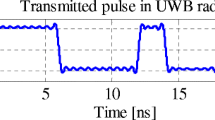Abstract
Impulsive ultra-wideband (UWB) radio provides many promising features for wireless communications in a dense multipath environment. However, these features are largely the result of the enormous effective processing gain, which can make acquisition difficult at the receiver. In this paper, a recently developed theory of minimum complexity sequential detection is applied to the hybrid acquisition problem. As in previous hybrid schemes, a number of potential timing phases are checked as a group; however, a phase is disregarded as soon as it appears unlikely rather than waiting for a “winner” to be chosen from the group. Another phase then replaces the disregarded one. Analysis and simulation results indicate that the proposed scheme can improve average acquisition times for highly spread systems operating over either additive white Gaussian noise (AWGN) or multipath fading channels.
Similar content being viewed by others
Explore related subjects
Discover the latest articles and news from researchers in related subjects, suggested using machine learning.References
FCC First Report and Order: In the matter of Revision of Part 15 of the Commissions Rules Regarding Ultra-Wideband Transmission Systems, FCC 0248 April 2002.
Multiband OFDM Alliance SIG, “MultiBand OFDM Physical Layer Proposal for IEEE 802.15 Task Group 3a, ” available at http://www.multibandofdm.org/.
R. Kennedy, Fading Dispersive Communication Channels. New York: Wiley-Onterscience, 1969.
I. Telatar and D. Tse, “Capacity and Mutual Information of Wideband Multipath Fading Channels,” IEEE Transactions on Information Theory Vol. 46: pp. 1384–1400, July 2000.
M. Medard and R. Gallager, “Bandwidth Scaling for Fading Multipath Channels,” IEEE Transactions on Information Theory Vol. 48: pp. 840–852, April 2002.
V. Veeravalli and C. Baum, “Hybrid acquisition of direct sequence CDMA signals,” International Journal of Wirless Information Network vol. 3, pp. 55–65, No. 1 1996.
M. Zhu and K. M. Chugg, “Iterative message-passing algorithms for rapid PN code acquisition,” IEEE Conference on Military Communications (MILCOM) Boston, MA, Nov. 2003.
Y. Chao and R. Schultz, “Optimal and suboptimal receivers for ultra-wideband transmitted reference systems,” IEEE Global Telecommunications Conference (GLOBECOM), San Fransico, CA, Dec. 2003.
M. Win and R. Scholtz, “Ultra-wide bandwidth time-hopping spread-spectrum impulse radio for wireless multiple-access communications,” IEEE Transaction on Communications vol. 48, No. 4, Apr. 2000.
P. Runkle, J. McCorkle, T. Miller and M. Welborn, “DS-CDMA: the modulation technology of choice for UWB communications,” IEEE Conference on Ultra Wideband Systems and Technologies Reston, VA, Nov. 2003.
W. Lovelace and J. Townsend, “The Effects of Timing Jitter and Tracking on the Performance of Impulse Radio,” IEEE Journal on Selected Areas of Communications pp. 1646–1651, vol. 20, no. 9, Dec. 2002.
A. Wald, Sequential Analysis, New York: Wiley and Sons, 1947.
C. Baum and V. Veeravalli, “A sequential procedure for multihypothesis testing,” IEEE Trans. on Inform. Theory vol.40, pp. 1994–2007, Nov. 1994.
C. Kose, Optimal Adaptive Transmitter and Receiver Techniques Master's Thesis, University of Massachusetts at Amherst, May 2000.
C. Kose, D. Goeckel and S. Wei, “Minimum complexity sequential multihypothesis decision: theory and reduced complexity decoding,” International Symposium on Information Theory June 2001.
K. K. Chawla and D. V. Sarwate, “Acquisition of PN sequences in chip synchronous DS/SS systems using a random sequence model and the SPRT,” IEEE Transaction on Communications vol. 42, no. 6, Jun 1994.
V.P. Dragalin, A.G. Tartakovsky and V.V. Veeravalli, “Multihypothesis sequential probability ratio tests, part I: Asymptotic optimality,” IEEE Trans. Inform. Theory vol. 45, pp.2448-2461, Nov. 1999.
V. Dragalin, A. Tartakovsky and V. Veeravalli, “Multihypothesis sequential probability ratio tests, part II: Accurate asymptotic expansions for the expected sample size,” IEEE Trans. Inform. Theory vol. 46, pp. 1366–1383, July 2000.
A. Polydoros and C. Weber, “A unified approach to serial search spread-spectrum code acquisition. I. II.,” IEEE Trans. Commun. vol. COM-32, no.5, pp. 542–549, May 1984.
E. Homier and R. Scholtz, “Rapid acquisition of ultra-wideband signals in the dense multipath channel,” IEEE Conference on UWB Systems and Technologies Baltimore, MD, May 2002.
Author information
Authors and Affiliations
Corresponding author
Additional information
This paper is based in part upon work supported by the Army Research Office under Contract DAAD10-01-1-0477 and employed equipment obtained under National Science Foundation Grant EIA-0080119.
Rights and permissions
About this article
Cite this article
Zhang, H., Goeckel, D.L., Wei, S. et al. Rapid Hybrid Acquisition of Ultra-Wideband Signals. J VLSI Sign Process Syst Sign Image Video Technol 43, 7–23 (2006). https://doi.org/10.1007/s11265-006-7277-z
Published:
Issue Date:
DOI: https://doi.org/10.1007/s11265-006-7277-z




